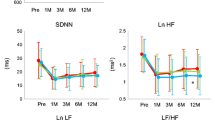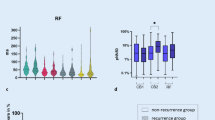Abstract
Background
Few studies have reported on the quantitative evaluation of autonomic nerve modification after balloon ablation. Therefore, this study aimed to evaluate the effects of cryoballoon and hotballoon ablations on the autonomic nervous system (ANS) and their relationship with prognosis.
Methods
We included 234 patients who underwent cryoballoon ablation (n = 190) or hotballoon ablation (n = 44) for paroxysmal atrial fibrillation. Heart rate variability (HRV) analysis was performed on all patients using a 3-min electrocardiogram at baseline, 1, 3, 6, and 12 months after ablation. HRV parameters and prognoses were compared between the two balloon systems.
Results
Ln low-frequency (LF), Ln high-frequency (HF), standard deviation of the R-R intervals (SDNN), and RR intervals significantly decreased after 1 month in both groups, but the changes were more pronounced in the cryoballoon group than in the hotballoon group. In contrast, HRV indices in the hotballoon ablation group decreased gradually and reached their lowest point 3-to-6 months after the procedure, which was later than in the cryoballoon ablation group. The recurrence rate did not differ between the two groups. HRV parameters changed similarly in the cryoballoon group, regardless of recurrence. However, patients with recurrence had significantly higher SDNN and Ln LF at 12 months than those without recurrence in the hotballoon group (41.2 ± 39.3 ms vs. 18.5 ± 12.6 ms, p = 0.006, and 2.2 ± 0.7 ms2 vs. 1.5 ± 0.7 ms2, p = 0.003, respectively).
Conclusions
The time course of HRV changes differed between cryoballoon and hotballoon ablations. Hence, the two balloon systems may have distinct effects on the ANS and its role in prognosis.
Graphical abstract






Similar content being viewed by others
References
Lim PB, Malcolme-Lawes LC, Stuber T, Wright I, Francis DP, Davies DW, et al. Intrinsic cardiac autonomic stimulation induces pulmonary vein ectopy and triggers atrial fibrillation in humans. J Cardiovasc Electrophysiol. 2011;22(6):638–46. https://doi.org/10.1111/j.1540-8167.2010.01992.x.
Tomita T, Takei M, Saikawa Y, Hanaoka T, Uchikawa S, Tsutsui H, et al. Role of autonomic tone in the initiation and termination of paroxysmal atrial fibrillation in patients without structural heart disease. J Cardiovasc Electrophysiol. 2003;14(6):559–64. https://doi.org/10.1046/j.1540-8167.2003.02462.x.
Xi Y, Cheng J. Dysfunction of the autonomic nervous system in atrial fibrillation. J Thorac Dis. 2015;7(2):193–8. https://doi.org/10.3978/j.issn.2072-1439.2015.01.12.
Qin M, Zeng C, Liu X. The cardiac autonomic nervous system: A target for modulation of atrial fibrillation. Clin Cardiol. 2019;42(6):644–52. https://doi.org/10.1002/clc.23190.
Aksu T, Yalin K, Mutluer FO, Farhat K, Tanboga HI, Po SS, et al. The impact of the clinical diagnosis on the vagal response and heart rate after ganglionated plexus ablation. J Interv Card Electrophysiol. 2022. https://doi.org/10.1007/s10840-022-01270-5.
Miyazaki S, Nakamura H, Taniguchi H, Hachiya H, Kajiyama T, Watanabe T, et al. Autonomic nervous system modulation and clinical outcome after pulmonary vein isolation using the second-generation cryoballoon. J Cardiovasc Electrophysiol. 2017;28(9):1015–20. https://doi.org/10.1111/jce.13262.
Yang D, Xi Y, Ai T, Wu G, Sun J, Razavi M, et al. Vagal stimulation promotes atrial electrical remodeling induced by rapid atrial pacing in dogs: evidence of a noncholinergic effect. Pacing Clin Electrophysiol. 2011;34(9):1092–9. https://doi.org/10.1111/j.1540-8159.2011.03133.x.
Aksu T, Yalin K, Bozyel S, Gopinathannair R, Gupta D. The anatomical basis behind the neuromodulation effects associated with pulmonary vein isolation. J Cardiovasc Electrophysiol. 2021;32(6):1733–6. https://doi.org/10.1111/jce.15038.
Pappone C, Santinelli V, Manguso F, Vicedomini G, Gugliotta F, Augello G, et al. Pulmonary vein denervation enhances long-term benefit after circumferential ablation for paroxysmal atrial fibrillation. Circulation. 2004;109(3):327–34. https://doi.org/10.1161/01.cir.0000112641.16340.c7.
Lemola K, Chartier D, Yeh YH, Dubuc M, Cartier R, Armour A, et al. Pulmonary vein region ablation in experimental vagal atrial fibrillation: role of pulmonary veins versus autonomic ganglia. Circulation. 2008;117(4):470–7. https://doi.org/10.1161/circulationaha.107.737023.
Bauer A, Deisenhofer I, Schneider R, Zrenner B, Barthel P, Karch M, et al. Effects of circumferential or segmental pulmonary vein ablation for paroxysmal atrial fibrillation on cardiac autonomic function. Heart Rhythm. 2006;3(12):1428–35. https://doi.org/10.1016/j.hrthm.2006.08.025.
Scanavacca M, Pisani CF, Hachul D, Lara S, Hardy C, Darrieux F, et al. Selective atrial vagal denervation guided by evoked vagal reflex to treat patients with paroxysmal atrial fibrillation. Circulation. 2006;114(9):876–85. https://doi.org/10.1161/circulationaha.106.633560.
Katritsis DG, Pokushalov E, Romanov A, Giazitzoglou E, Siontis GC, Po SS, et al. Autonomic denervation added to pulmonary vein isolation for paroxysmal atrial fibrillation: a randomized clinical trial. J Am Coll Cardiol. 2013;62(24):2318–25. https://doi.org/10.1016/j.jacc.2013.06.053.
Yanagisawa S, Suzuki H, Kanzaki Y, Ishikawa S, Kamikubo Y, Okumura S, et al. Efficacy and feasibility of cryoballoon ablation for atrial fibrillation in patients with heart failure: A large-scale multicenter study. J Cardiovasc Electrophysiol. 2022. https://doi.org/10.1111/jce.15691.
Sohara H, Ohe T, Okumura K, Naito S, Hirao K, Shoda M, et al. HotBalloon Ablation of the Pulmonary Veins for Paroxysmal AF: A Multicenter Randomized Trial in Japan. J Am Coll Cardiol. 2016;68(25):2747–57. https://doi.org/10.1016/j.jacc.2016.10.037.
Nagashima K, Okumura Y, Watanabe I, Nakahara S, Hori Y, Iso K, et al. Hot Balloon Versus Cryoballoon Ablation for Atrial Fibrillation: Lesion Characteristics and Middle-Term Outcomes. Circ Arrhythm Electrophysiol. 2018;11(5):e005861. https://doi.org/10.1161/circep.117.005861.
Yanagisawa S, Inden Y, Ohguchi S, Nagao T, Fujii A, Tomomatsu T, et al. Periprocedural Management of Cardiac Tamponade During Catheter Ablation for AF Under Uninterrupted DOAC and Warfarin. JACC Clin Electrophysiol. 2020;6(7):786–95. https://doi.org/10.1016/j.jacep.2020.02.005.
Nogami A, Kurita T, Abe H, Ando K, Ishikawa T, Imai K, et al. JCS/JHRS 2019 guideline on non-pharmacotherapy of cardiac arrhythmias. J Arrhythm. 2021;37(4):709–870. https://doi.org/10.1002/joa3.12491.
Yanagisawa S, Inden Y, Fujii A, Kamikubo Y, Kanzaki Y, Ando M, et al. Assessment of autonomic nervous system modulation after novel catheter ablation techniques for atrial fibrillation using multiple short-term electrocardiogram recordings. J Interv Card Electrophysiol. 2018;51(1):35–44. https://doi.org/10.1007/s10840-017-0295-x.
Heart rate variability: standards of measurement, physiological interpretation and clinical use. Task Force of the European Society of Cardiology and the North American Society of Pacing and Electrophysiology. Circulation. 1996;93(5):1043–65.
Armour JA, Murphy DA, Yuan BX, Macdonald S, Hopkins DA. Gross and microscopic anatomy of the human intrinsic cardiac nervous system. Anat Rec. 1997;247(2):289–98. https://doi.org/10.1002/(sici)1097-0185(199702)247:2%3c289::aid-ar15%3e3.0.co;2-l.
Kanda S, Amino M, Sakama S, Ayabe K, Sakai T, Nagamatsu H, et al. Relation Between Autonomic Nervous Activity after Pulmonary Vein Isolation and Recurrence in Paroxysmal Atrial Fibrillation Patients. Tokai J Exp Clin Med. 2018;43(4):153–60.
Yanagisawa S, Inden Y, Mizutani Y, Fujii A, Kamikubo Y, Kanzaki Y, et al. Vagal response in cryoballoon ablation of atrial fibrillation and autonomic nervous system: Utility of epicardial adipose tissue location. J Arrhythm. 2017;33(4):275–82. https://doi.org/10.1016/j.joa.2017.03.001.
Galloo X, Abugattas JP, Tijskens M, Dendale P, Varnavas V, Wolf M, et al. Impact of cryoballoon-guided pulmonary vein isolation on non-invasive autonomic tests in patients with paroxysmal atrial fibrillation. Indian Pacing Electrophysiol J. 2019;19(5):171–7. https://doi.org/10.1016/j.ipej.2019.05.002.
Mori H, Kato R, Ikeda Y, Goto K, Tanaka S, Asano S, et al. Analysis of the heart rate variability during cryoballoon ablation of atrial fibrillation. Europace. 2018;20(8):1259–67. https://doi.org/10.1093/europace/eux225.
Akita T, Kiuchi K, Fukuzawa K, Shimane A, Matsuyama S, Takami M, et al. Lesion distribution after cryoballoon ablation and hotballoon ablation: Late-gadolinium enhancement magnetic resonance imaging analysis. J Cardiovasc Electrophysiol. 2019;30(10):1830–40. https://doi.org/10.1111/jce.14073.
Sohara H, Takeda H, Ueno H, Oda T, Satake S. Feasibility of the radiofrequency hot balloon catheter for isolation of the posterior left atrium and pulmonary veins for the treatment of atrial fibrillation. Circ Arrhythm Electrophysiol. 2009;2(3):225–32. https://doi.org/10.1161/circep.108.817205.
Takami M, Misiri J, Lehmann HI, Parker KD, Johnson SB, Sarmiento RI, et al. Spatial and time-course thermodynamics during pulmonary vein isolation using the second-generation cryoballoon in a canine in vivo model. Circ Arrhythm Electrophysiol. 2015;8(1):186–92. https://doi.org/10.1161/circep.114.002137.
Sekihara T, Miyazaki S, Aoyama D, Nagao M, Tsuji T, Kakehashi S, et al. Evaluation of cryoballoon pulmonary vein isolation lesions during the acute and chronic phases using a high-resolution mapping system. J Interv Card Electrophysiol. 2022;65(1):123–31. https://doi.org/10.1007/s10840-022-01225-w.
Miyazaki S, Taniguchi H, Hachiya H, Nakamura H, Takagi T, Iwasawa J, et al. Quantitative Analysis of the Isolation Area During the Chronic Phase After a 28-mm Second-Generation Cryoballoon Ablation Demarcated by High-Resolution Electroanatomic Mapping. Circ Arrhythm Electrophysiol. 2016;9(5):e003879. https://doi.org/10.1161/circep.115.003879.
Ding L, Hou B, Wu L, Qiao Y, Sun W, Guo J, et al. Delayed efficacy of radiofrequency catheter ablation on ventricular arrhythmias originating from the left ventricular anterobasal wall. Heart Rhythm. 2017;14(3):341–9. https://doi.org/10.1016/j.hrthm.2016.12.006.
Neumann J, Ligtenberg G, Klein IH, Boer P, Oey PL, Koomans HA, et al. Sympathetic hyperactivity in hypertensive chronic kidney disease patients is reduced during standard treatment. Hypertension (Dallas, Tex: 1979). 2007;49(3):506–10. https://doi.org/10.1161/01.HYP.0000256530.39695.a3.
Acknowledgements
The authors thank all medical and clinical engineering staff at Nagoya University for their assistance during the ablation procedure. We also acknowledge Naoto Yoshida (APEX, Inc.) and Takahiro Nagase (Toray Medical Japan) for their excellent support in setting the experiment model, delivering a lecture on the ballooning mechanism, and arranging the balloon catheters.
Funding
This study was funded by Medtronic Japan and Grant-in-Aid for Young Scientists 19K17558.
Author information
Authors and Affiliations
Corresponding author
Ethics declarations
Ethics approval and consent to participate
This study was approved by the local institutional ethics committee of Nagoya University Hospital. All patients provided written informed consent prior to the procedure.
Conflict of interest
Drs. Yanagisawa and Shibata belong to an endowed department sponsored by Medtronic Japan Co., Ltd. Drs. Shimojo and Tsuji are affiliated with a department sponsored by Japan Lifeline Co., Ltd., BIOTRONIK Japan, Inc., FUKUDA DENSHI Co., Ltd., and SUZUKEN Co., Ltd.
Additional information
Publisher's note
Springer Nature remains neutral with regard to jurisdictional claims in published maps and institutional affiliations.
Supplementary Information
Below is the link to the electronic supplementary material.
Rights and permissions
Springer Nature or its licensor (e.g. a society or other partner) holds exclusive rights to this article under a publishing agreement with the author(s) or other rightsholder(s); author self-archiving of the accepted manuscript version of this article is solely governed by the terms of such publishing agreement and applicable law.
About this article
Cite this article
Suzuki, N., Inden, Y., Yanagisawa, S. et al. Different time course effect of autonomic nervous modulation after cryoballoon and hotballoon catheter ablations for paroxysmal atrial fibrillation. J Interv Card Electrophysiol (2023). https://doi.org/10.1007/s10840-023-01581-1
Received:
Accepted:
Published:
DOI: https://doi.org/10.1007/s10840-023-01581-1




